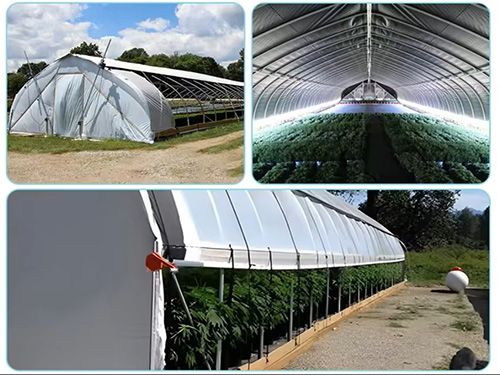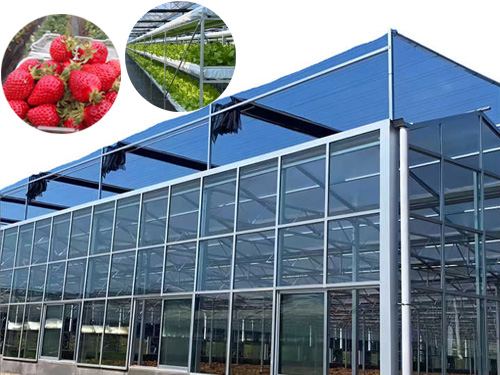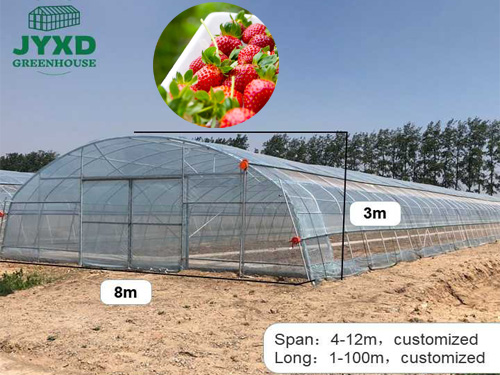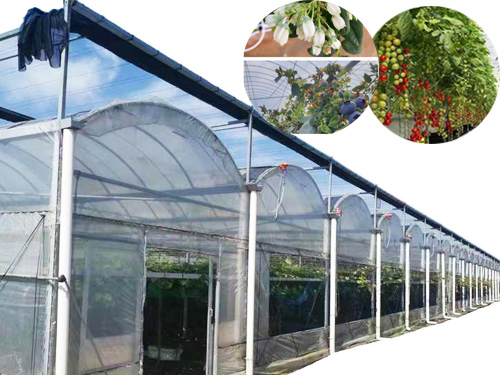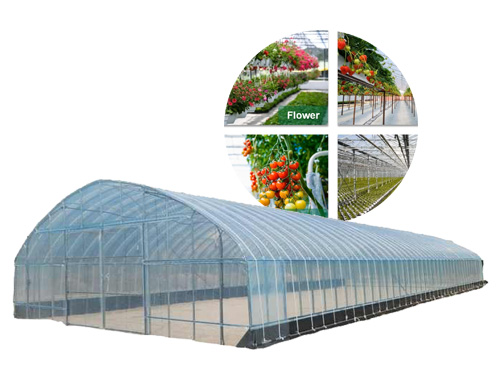NEWS DETAILS
NEWS INFORMATION
Cut Flower Production in Greenhouses: From Seedlings to Market Sales
AUTHOR:jyxd-greenhouse DATE:2025-01-19 16:38:55 HITS:123
Cut flower production is a thriving industry, especially within controlled environments such as greenhouses. Greenhouses provide an ideal setting for growing flowers, offering the ability to control environmental factors and extend the growing season. This article delves into the process of cut flower production in greenhouses, from the initial seedling stage to the final market sale. We will explore the best practices, technologies, and strategies for ensuring a successful and profitable cut flower operation.
The Importance of Greenhouses in Cut Flower Production
Greenhouses provide numerous advantages for growing cut flowers, especially when compared to open-field farming. By creating an enclosed environment, greenhouses allow for the control of temperature, humidity, light, and air circulation. These factors contribute to healthier plants, faster growth, and higher-quality flowers. The controlled climate also allows growers to produce flowers year-round, ensuring a steady supply for the market.
Some key benefits of greenhouse-based cut flower production include:
· Optimal Growing Conditions: Greenhouses help maintain a stable environment for plants, reducing the risks of disease, pests, and extreme weather conditions.
· Increased Yields: With consistent care and environmental control, greenhouses can produce higher-quality flowers with greater consistency and productivity.
· Extended Growing Season: Greenhouses extend the growing season, allowing flowers to be grown and harvested outside of traditional growing months.
In addition to these advantages, the ability to monitor and control environmental conditions is critical for cut flower production, ensuring that flowers meet market demands for quality and appearance.
Step 1: Growing Cut Flower Seedlings in Greenhouses
The process of cut flower production begins with selecting the right seedlings or seeds. The choice of flower variety plays a significant role in determining the marketability and profitability of the operation. Popular cut flowers grown in greenhouses include roses, lilies, tulips, gerbera daisies, and chrysanthemums.
1. Choosing the Right Flower Varieties
Choosing flower varieties that are well-suited for greenhouse production is essential. Factors such as flower size, color, fragrance, and durability during transportation must be considered when selecting flowers for the market. Growers should focus on varieties that have a high demand and can withstand the environmental conditions of the greenhouse.
2. Seedling Preparation
Once the flower variety is selected, the next step is to start the seedlings. Seeds are typically sown in trays or pots, and it’s important to maintain ideal conditions for germination. The temperature, moisture level, and light exposure must be closely monitored to ensure that the seedlings develop into healthy plants.
· Optimal Temperature: Different flowers have varying temperature requirements for germination. For example, roses require a temperature range of 70°F-75°F, while lilies prefer cooler temperatures.
· Humidity and Moisture: Proper humidity levels are essential for seedling growth. It is important to avoid over-watering, as this can lead to root rot or fungal diseases.
Once the seedlings are established, they can be transplanted into larger pots or directly into the greenhouse beds, depending on the flower variety and growing method.
Step 2: Growing and Cultivating Flowers
After transplanting the seedlings into the greenhouse, the cultivation process begins. This involves carefully managing temperature, light, humidity, irrigation, and fertilization to ensure optimal plant growth.
1. Environmental Control
Greenhouses offer the advantage of controlling environmental conditions. Managing these factors ensures the flowers grow to their full potential:
· Temperature Management: Flowers like roses thrive at temperatures between 65°F and 70°F. Growers use thermostats and climate control systems to adjust temperatures according to plant requirements.
· Light Regulation: Adequate light is crucial for flower growth, as it influences blooming and the development of flower color. Greenhouse lighting systems, including LED lights, can supplement natural sunlight during cloudy days or the winter months.
· Humidity and Air Circulation: Maintaining proper humidity levels helps prevent fungal diseases and other health issues. Good air circulation reduces the risk of diseases such as powdery mildew and botrytis.
2. Watering and Irrigation
Efficient irrigation systems are essential for maintaining healthy plants. In greenhouses, a variety of automated irrigation systems are used, such as drip irrigation, to ensure that flowers receive the correct amount of water. Over-watering can lead to root diseases, while under-watering can cause wilting and reduced flower quality.
3. Fertilization
Regular fertilization provides flowers with the necessary nutrients for strong growth and abundant blooms. Greenhouse growers often use controlled-release fertilizers or fertigation systems, which mix fertilizer with irrigation water. The correct nutrient balance is essential to producing flowers with vibrant colors, strong stems, and long vase life.
Step 3: Harvesting Cut Flowers
The timing of harvest is critical in cut flower production. Flowers must be harvested at the right stage of development to ensure they are both high-quality and able to last through transportation and shelf life.
1. Optimal Harvest Time
Each type of flower has a specific stage of growth at which it should be harvested. For example, roses are typically harvested when the buds are just beginning to open, while lilies are harvested when the buds are still tightly closed. The goal is to ensure that flowers reach their destination in peak condition, where they can fully open and bloom.
2. Harvesting Techniques
Careful harvesting techniques are important to avoid damaging the flowers. Growers typically use sharp, clean tools to cut flowers at an angle, leaving an adequate length of stem for easy handling and arrangement. Flowers should be handled gently to prevent bruising or other damage that may affect their marketability.
Step 4: Post-Harvest Handling and Storage
Once the flowers are harvested, proper handling and storage are essential for maintaining their quality until they reach the market. Post-harvest care includes cleaning, conditioning, and storing the flowers under optimal conditions.
1. Cleaning and Conditioning
After harvesting, flowers should be cleaned of any debris and placed in water to keep them hydrated. Conditioning involves allowing the flowers to drink water and adjust to the new temperature before being packaged for sale.
2. Storage and Transportation
Temperature is crucial in post-harvest storage. Flowers are typically stored in cool storage rooms to slow down the aging process and extend vase life. For flowers that need to be transported, refrigerated trucks or containers are often used to maintain freshness during transit.
Step 5: Selling Cut Flowers in the Market
Once the flowers are properly conditioned, the final step is marketing and selling them. High-quality cut flowers can be sold to wholesalers, retailers, florists, or directly to consumers through farmers' markets and online platforms. The key to successful flower sales is ensuring that the flowers are consistently high quality and in demand.
1. Market Trends and Demand
Growers should stay informed about market trends to ensure they produce flowers that are in demand. Popular flowers such as roses, tulips, and sunflowers tend to have a steady market, but trends can change with seasons or cultural events. For example, certain flowers may see an increase in demand during holidays such as Valentine’s Day or Mother’s Day.
2. Packaging and Presentation
Flowers must be packaged carefully to avoid damage during transportation and to ensure they are visually appealing for the market. Proper packaging also helps to prolong the flowers' shelf life and maintain their quality.
Conclusion
Cut flower production in greenhouses is a multi-step process that requires careful attention to detail from seedling to market sale. By managing environmental conditions, irrigation, fertilization, and post-harvest handling, greenhouse growers can produce high-quality flowers that meet market demand. With the right tools, techniques, and strategies, cut flower producers can thrive in a competitive industry, offering consumers beautiful blooms year-round.
Hebei Juyou Xinda Greenhouse Facilities Co.,Ltd.
Copyright © 2024-2025 https://www.jyxd-greenhouse.com. All Rights Reserved Hebei Juyou Xinda Greenhouse Facilities Co.,Ltd.Copyright





 Current Location:
Current Location:


